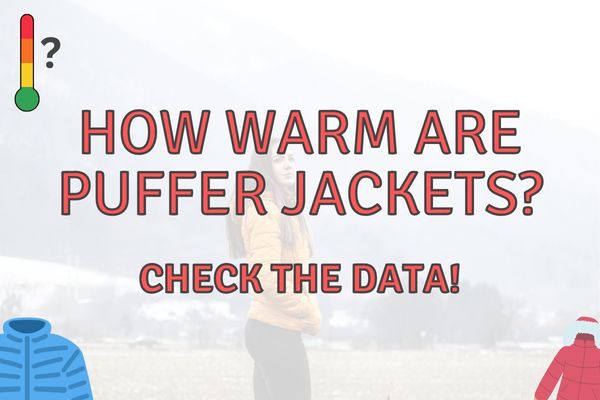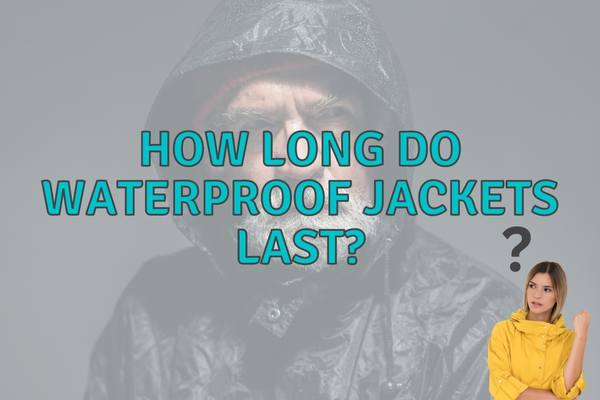Puffer jackets, sometimes referred to as “down jackets” although they don’t always contain real down, are a popular winter fashion staple – but how warm are puffer jackets really?
Puffer jackets are very warm and warm enough for most winters. A good down jacket will keep you comfortable down to around -15F (-26C).
The exact temperature rating of a puffer jacket depends on:
- The type of insulation material (down or synthetic).
- The amount of insulation material.
- The fill power (cuin) of the insulation material.
- The outer shell fabric (nylon, polyester or membrane).
- The weather conditions (will be less warm if wet or very windy).
Most down jackets contain between 2 and 6 ounces of down at a fill power around 800 cuin.
This makes the average puffer jacket ideal at somewhat below freezing point at around 10 to 20 Fahrenheit or -6 to -16 Celsius.
The graph below shows the distribution of warmth (comfort temperature at moderate activity) for some down and synthetic puffer jackets (see table later for jacket names).
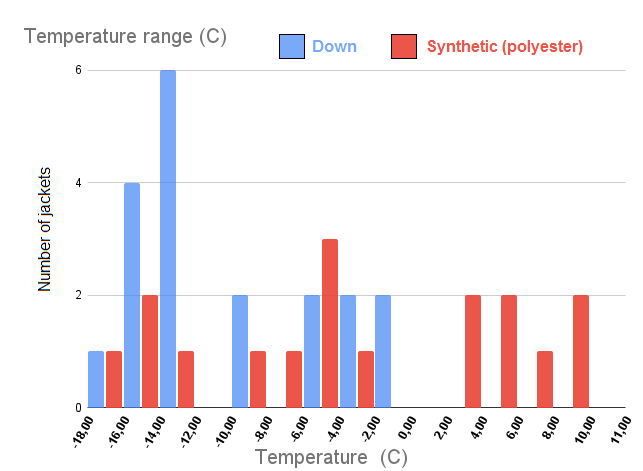
The distribution of the jackets along the temperature axis shows that puffer jackets are quite warm! And that down puffers are generally warmer than synthetic (polyester) ones.
We’ll break down the ins and outs of puffer jackets, the optimal temperatures to wear them and tips on how and when to wear them and how to improve their warmth.
Contents
How Warm are Puffer Jackets?
A puffer down jacket is a type of insulated coat that has been designed to keep you warm in cold weather.
It typically consists of an outer shell made from nylon or polyester, and an inner filling of down feathers or synthetic insulation.
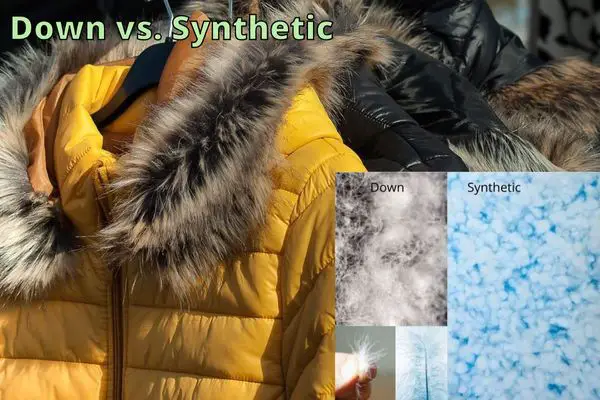
The most common insulating materials used in these jackets are goose or duck down and polyester-based man-made synthetics.
Natural down is ultra-lightweight and compact, not only that, it’s super warm and exceptionally efficient at trapping heat, while synthetic insulation is more affordable and offers more water resistance.
With so many options available, it can be difficult to decide which type of puffer jacket is the best choice for keeping you warm during winter.
How warm are puffer jackets with down filling?
Puffer down jackets are a go-to choice for outdoor activity, providing warmth and coziness during colder months. Thanks to the advanced insulation they offer, puffer jackets can keep wearers warm in temperatures ranging from 10 ℉ to -60℉; this means weathering extremely cold climates is no longer an issue!
The sophisticated design of puffer coats offered today ensures that wearers not only stay comfortably warm, but also stylish. Different layers trap heat while the water-resistant outer layer shields against wet conditions.
Furthermore, high-quality materials such as goose or duck down provide lightweight comfort and further increase the efficacy in trapping body heat.
The jackets below are down jackets and most of them are also considered puffer jackets. The warmth is given as a relative scale based on the filling and their fill power:
The warmest jacket in the table, The GooseFeet Gear Box Jacket, will keep you comfortable to at least -13F or -25C, but the Rab Zero G will do the same at a moderate activity level.
The Feathered Friends Eos jacket is good at temperatures down to 8F or -13C, which is good enough for most winters in the US.
Whether one prefers spending time outdoors camping or hiking or simply desires a fashionable upgrade for their winter wardrobe, puffer down jackets offer perfect protection against icy temperatures!
How warm are puffer jackets with synthetic filling?
Puffer jackets with synthetic filling can provide a good level of warmth, depending on the type of insulation used and the weight of the jacket.
Synthetic insulation is known to perform well when damp and dry quickly, which is an advantage over natural down insulation.
They are also much easier to take care of since it can usually just be thrown into a washing machine with regular detergent without any special treatment needed afterwards like natural down needs.
However, synthetic insulation is typically heavier and less packable than down, and may not be as durable.
In the table below I have ranked some of the available puffer jackets with synthetic insulation in order of warmth/insulation level based on their loft and amount and type of insulation material:
| Jacket | Comfort Temperature (F) | Comfort Temperature (C) |
| Arc’teryx Dually Belay (Men’s) | 0 | -18 |
| Arc’teryx Fission SV (Men’s – Women’s) | 3 | -16 |
| Arc’teryx Nuclei SV (Men’s) | 5 | -15 |
| Arc’teryx Kappa (Men’s) | 7 | -14 |
| Arc’teryx Beta Insulated Coat (Women’s) | 16 | -9 |
| Arc’teryx Atom AR (Men’s – Women’s) | 18 | -8 |
| Arc’teryx Beta Insulated (Men’s – Women’s) | 21 | -6 |
| Arc’teryx Alpha IS (Men’s) | 23 | -5 |
| Rab Xenon 2.0 (Men’s – Women’s) | 23 | -5 |
| Arc’teryx Therme Insulated (Men’s) | 26 | -3 |
| Arc’teryx Proton LT (Men’s – Women’s) | 37 | 3 |
| Patagonia Nano Puff (Men’s – Women’s) | 37 | 3 |
| Arc’teryx Norvan SL Ins. (Men’s – Women’s) | 39 | 4 |
| Patagonia Nano Air (Men’s – Women’s) | 41 | 5 |
| Arc’teryx Atom LT (Men’s – Women’s) | 43 | 6 |
| Arc’teryx Proton Hybrid (Men’s – Women’s) | 46 | 8 |
| Arc’teryx Proton FL (Men’s) | 48 | 9 |
| Arc’teryx Atom SL (Men’s – Women’s) | 52 | 11 |
The warmth of a puffer jacket with synthetic filling can be affected by factors such as the weight of the insulation and the type of liner material used.
For example, a jacket with a high weight of synthetic insulation may be warmer than one with a lower weight.
Additionally, some synthetic insulation jackets are designed for high-output activities, such as backcountry pursuits, and prioritize breathability over maximum warmth.
If you’re looking for specific examples of puffer jackets with synthetic filling and their warmth levels, the table provided includes a variety of options from the brand Arc’teryx and Patagonia.

For example, the Arc’teryx Dually Belay (Men’s) has a temperature range of 0 degrees Fahrenheit, or -18 degrees Celsius, while the Arc’teryx Proton FL (Men’s) has a temperature range of 48 degrees Fahrenheit, or 9 degrees Celsius.
Additionally, the Patagonia Nano Puff (Men’s – Women’s) and the Arc’teryx Proton LT (Men’s – Women’s) both have a temperature range of 37 degrees Fahrenheit, or 3 degrees Celsius.
Overall, it’s important to consider the specific insulation, weight, and temperature range of a jacket when evaluating its warmth level.
Overall, puffer jackets with synthetic filling can provide a good level of warmth, but it’s important to consider the weight of the insulation and the type of liner material used when choosing a jacket.
You can also check the temperature range as per the jacket in the table above and compare with the outside temperature and weather conditions in order to make the right decision.
In summary –
When shopping for a puffer jacket, it is important to consider the activities you plan on doing and choose natural or synthetic fill accordingly.
Additionally, determine which type of waterproofing material would best suit your needs.
The three main options are DWR coating, laminated membrane fabric, or taped seams with waterproof zippers; each offering different levels of protection and breathability depending on the situation.
What puffer jacket is warmest then?
With plenty of winter jacket choices available, it can be hard to know what the warmest option for frigid weather is.
From the tables in the previous sections, we can see the following:
It terms of total warmth from a puffer jacket, the GooseFeet Gear Box Jacket is considered the warmest puffer down jacket available, closely followed by the Nunatak Shaka UL hooded Sweater and then a fairly big gap to the warmer mid-range jackets such as Rab Zero G and the Montane Alpine 850 Lite.
Why are puffer jackets so warm?
Puffer jackets keep you warm by sandwiching a layer of warming insulation between two layers of nylon or polyester fabric.
Insulation works by keeping air still close to your body so that the warm air cannot be switched out with new cold air.
Down have excellent insulating properties due to its ability to trap air within the tiny pockets between the individual feathers.
This creates thousands of tiny air pockets which help keep your body warm by trapping heat (warm air) close to your skin while still allowing moisture vapour out so you don’t overheat.
The higher the fill power rating on a down jacket, the more efficient it will be at keeping you warm in cold temperatures.
Synthetic insulation is lightweight and can provide the same warmth as down, while down-filled puffer jackets are great for colder temperatures.
Hybrid puffer jackets, which use both down and synthetic insulation, are becoming increasingly popular due to their ability to provide warmth in a variety of conditions.
What are the warmest puffer jackets with synthetic filling?
The warmth of a puffer jacket can vary depending on the specific jacket and its features.
The Big Agnes Women’s Luna Jacket and Men’s Shovelhead Jacket are often mentioned as the “best overall” puffer jackets for warmth.
The Outdoor Research SuperStrand LT Hoodie is also mentioned as a “Best Synthetic” option for warmth.
Additionally, the Aritzia Super Puff is noted for its ability to keep the wearer warm in temperatures as low as -22 degrees Fahrenheit. The general rule of thumb is that the puffier the jacket, the warmer it will be.
It is also worth noting that the puffer jackets may have different insulation such as PrimaLoft (40g, 60g, 80g, etc), Thinsulate (40, 60, 100g, etc), 40g Pluma Fill and so on.
It would be good idea to check the insulation and the weight of the jacket before purchasing to get an idea of how warm it would be or simply try it on and feel the warmth!
When to wear a down jacket
When it comes to outdoor activities, dressing appropriately is key. A down jacket is an essential piece of clothing for cold weather and can help keep you warm and comfortable while outdoors.
Knowing when to wear a down jacket will ensure that you stay safe and enjoy your time outside.
Temperature Considerations
The temperature outside should be the first factor in deciding whether or not to wear a down jacket.
If the temperature is below 40 degrees Fahrenheit (4 degrees Celsius), then wearing a down jacket will generally be comfortable along with a long sleeved t-shirt underneath.
In temperatures between 40-50°F (4-10°C) it may still be necessary fine, depending on how active you plan on.
If you’ll be doing any strenuous activity, such as hiking or skiing, some puffer jackets may be too warm, but thin models like the Mountain Hardwear GW/2 or Arc’teryx Proton are fine with good breathable (woollen?) underwear as a base layer.
I also recommend the mountain hardwear ghost whisperer 2 for skiing and other outdoor activities.
The best temperature for puffer jackets is dependent on the type of insulation and fabric used. Different types of insulation will have different temperature ratings based on laboratory tests, with down-filled jackets typically providing the highest levels of warmth.
Synthetic-filled jackets may not be as warm as down-filled jackets, but they are still excellent at keeping the body warm and dry.
Hybrid jackets combine both down and synthetic materials for maximum warmth and comfort in cold weather conditions.
Other Weather Conditions to Consider
In addition to considering the temperature, it’s important to also take into account what type of weather conditions are present when deciding whether or not to wear a down jacket.
If there’s snowfall or heavy winds, then having some extra insulation from a down coat can provide additional warmth and protection against wind chill factors that can make temperatures feel much colder than they actually are.
Rainy days might require more waterproofing treatments on your puffer jacket as puffers are rarely waterproof, so that moisture will eventually seep through and cause discomfort and collapse of the insulation material due to wetness inside the garment itself.
If a puffer down jacket gets wet, it will need a special drying procedure to puff it back up, so try to avoid using your down jacket in the rain!

Water-resistant or water-repellent treatments applied onto certain fabrics can help protect against light rain showers but won’t necessarily hold up against heavier precipitation levels like those seen during thunderstorms or blizzards.
Activity Level
Your level of activity should be taken into consideration when deciding if you need an extra layer such as a down coat while outdoors in cold weather conditions.
If you are going out for leisurely walks around town without any physical exertion, one layer of clothing plus some gloves will likely suffice.
However, if you are participating in activities that involve increased movement speeds over short periods of time followed by rest intervals at regular intervals (such as stoplights), then layering with something like a lightweight puffer vest could provide enough insulation without causing excessive sweating.
If you activity level is high, you can add a few degrees to the comfort temperature estimate for a puffer jacket, but there are limits as puffer jackets are not super breathable!

Therefore, during high intensity activity, wearing a puffer jacket could lead to feeling chilled afterwards due to evaporative cooling effects from sweat.
Down jackets are a great choice for outdoor activities, providing warmth and protection from the elements.
However, it is important to know when to wear them in order to maximize their effectiveness. Next we will discuss how waterproof down jackets are.
Key Takeaway: When deciding whether or not to wear a down jacket for outdoor activities, temperature, weather conditions and activity level should all be taken into consideration. For temperatures below 40°F (4°C) wearing a down coat is beneficial for warmth; in addition, waterproof treatments may be necessary if there’s heavy rain or snowfall. Finally, your activity level will determine how much insulation you need – less active pursuits require lighter layers while more strenuous activities might necessitate additional layering with something like a puffer vest.
How to best wear a puffer down jacket?
A puffer down jacket is a great way to stay warm and comfortable in cold weather. It’s lightweight, breathable, and can be layered for extra warmth. But how do you wear it? Here are some tips on getting the most out of your puffer down jacket:
Layering: A puffer down jacket works best when layered with other pieces of clothing. For example, if you’re going skiing or snowboarding, layer a base layer shirt under your puffer down jacket for added insulation. You can also add an additional fleece or wool sweater over the top for even more warmth.
Fit: Make sure that your puffer down jacket fits properly so that it doesn’t restrict movement or leave any gaps between layers where cold air could get in. If possible, try on different sizes before purchasing to ensure the best fit.
Weatherproofing: Puffers are usually made from water-resistant materials like nylon and polyester but they may not always provide enough protection against rain and snowfall so make sure to invest in a waterproof shell as well if you plan on being outdoors during wet weather conditions.
This will help keep you dry while still providing plenty of warmth from the insulation inside your coat.
Accessories: To complete the look of your outfit, consider adding accessories such as gloves, hats and scarves which will help keep all parts of your body warm while looking stylish at the same time! Also don’t forget about sunglasses – UV rays can still reach us even when it’s cloudy outside so make sure to protect yourself accordingly!
Taking care of your puffers is essential for keeping them looking good and lasting longer. Avoid machine washing whenever possible since this could damage its insulation properties.
Instead, hand wash with mild detergent or spot clean only when necessary using a damp cloth. Hang up to dry naturally away from direct sunlight or heat sources such as radiators, etcetera.
By wearing a puffer down jacket, you can stay warm and dry while enjoying the outdoors. Now let’s explore how to waterproof your down jacket for extra protection from the elements.
Key Takeaway: A puffer down jacket is a great way to stay warm and comfortable in cold weather, but it’s important to layer correctly and use accessories for added warmth.
Additionally, make sure you invest in a waterproof shell if you plan on being outdoors during wet weather conditions. Finally, take care of your puffers by hand washing or spot cleaning with mild detergent when necessary and hang up to dry away from direct sunlight or heat sources.
Are puffer jackets for fall or winter?
Puffer jackets are a great choice for outdoor activities no matter the season; they provide excellent insulation and serve as an effective shield against wind, rain, or snow. However, when considering which season is best to wear your puffer jacket in, both fall and winter can be suitable choices.
In the case of fall temperatures, a lightweight puffer jacket is ideal. It’s able to keep you warm without making you overheat even in milder weather conditions due to its breathability characteristics.
For wintertime however, a thicker and more padded version of the same item becomes essential for cold days since it offers superior warmth on top of its inherent protective qualities like waterproofing abilities and elastic cuffs/ Collars that lock in body heat better than traditional coats alone.
Ultimately, any avid outdoorsman should have at least one puffer jacket available throughout their seasonal wardrobe rotations!
Are puffer jackets warm enough for snow and winter? (H3)
Puffer jackets are warm, lightweight winter coats designed to keep the wearer insulated from cold weather – so they are perfect for snow and winter!
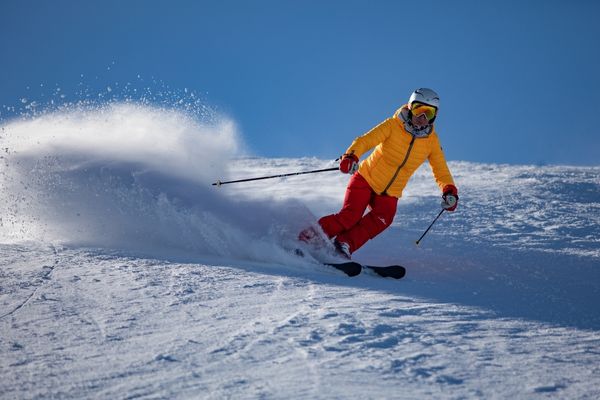
They consist of a fluofil-filled interior that holds warmth close to the body and provide an unbeatable combination of comfort and style.
Determining if puffer jackets are “warm enough” for snow or other extreme winter conditions depends on several factors; ideally, a jacket should resist moisture while maintaining heat at minus temperatures below -20° Fahrenheit (-29°C).
Additionally, its windproof ability must be superior to ensure maximum protection against fierce gusts common in places with treacherous climates.
Fortunately, many manufacturers make special-purpose puffers—with features such as water-repellent fabrics and synthetic insulation— ideal for any outdoor activity in severe weather.
You might need a waterproof shell on top!
A waterproof and breathable shell worn on top of a puffer jacket is essential to keeping you warm, dry, and comfortable as puffer jackets are usually not waterproof on their own.
Without it, the down will become wet and lose its insulating properties. The shell also helps to prevent sweat from building up inside the jacket by allowing moisture vapour to escape through tiny pores in the fabric.

When choosing a waterproof and breathable shell for your down jacket, look for one that has been treated with a durable water repellent (DWR) finish. This coating helps to repel water droplets so they don’t soak into the fabric of your outer layer.
It also prevents condensation from forming on the inside of your jacket which can make you feel cold or clammy when temperatures drop outside.
The best way to ensure that your waterproof and breathable shell does its job is by selecting one made from quality materials such as Gore-Tex or eVent fabrics.
These fabrics are designed specifically for outdoor activities like hiking or skiing where protection against wind, rain, snow, sleet and other elements is key. They provide superior levels of durability while still being lightweight enough not to weigh you down during long treks outdoors.
You should also consider how often you plan on wearing your down jacket before making a purchase decision since some shells may be more suitable than others depending on their intended use case scenario.
If you plan on using it only occasionally then investing in an expensive high-end model might not be necessary but if you intend on using it frequently then spending extra money could pay off in terms of performance over time due to better weatherproofing capabilities offered by higher end models compared with cheaper alternatives available at lower price points.

Finally, remember that proper care should always be taken when cleaning any type of waterproof/breathable garment. Never put them in washing machines or dryers as this can damage both their DWR finishes and their ability to effectively wick away moisture vapours from within.
Having a waterproof and breathable shell is essential for any outdoor enthusiast to stay warm, dry, and comfortable during their adventures. Now let’s explore the different types of down jackets available to ensure you have the best protection from the elements.
Key Takeaway: When choosing a waterproof and breathable shell for your down jacket, it is important to look for one that has been treated with a durable water repellent (DWR) finish. Quality materials such as Gore-Tex or eVent fabrics should be considered in order to provide superior levels of durability while still being lightweight enough not to weigh you down during outdoor activities. Additionally, proper care must be taken when cleaning any type of waterproof/breathable garment – never put them in washing machines or dryers.
How to take care of your down jacket
Down jackets are an essential part of any outdoor enthusiast’s wardrobe. Not only do they provide warmth and insulation, but they also look great! However, down jackets require special care to keep them looking and performing their best. Here are some tips on how to take care of your down jacket:
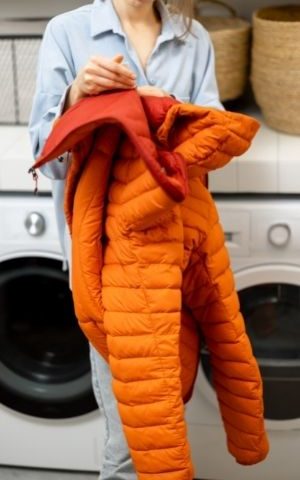
Spot Clean or Hand Wash – Spot cleaning is the best way to clean a down jacket as it prevents damage from washing machines. Use cold water and a mild detergent for spot cleaning or hand washing.
Gently squeeze out excess water after rinsing and lay the jacket flat in a cool, well-ventilated area away from direct heat sources to dry.
Fluff Up Feathers – Once the jacket is completely dry, fluff up the feathers by gently massaging them with your hands before storing in a cool, dry place until ready to wear again. This will help maintain its loftiness so that you can enjoy maximum warmth when wearing it outdoors.
Repel Water – To protect against moisture while hiking or camping, use waterproof sprays designed specifically for down jackets on both sides of the fabric before heading out into wet weather conditions. Reapply every few months depending on how often you wear your coat outdoors.
Store Properly – When not in use, store your down jacket in a breathable garment bag or cotton pillowcase instead of plastic bags which trap moisture inside and cause mold growth over time due to condensation buildup within the fabric fibers .
Additionally make sure there is enough room around each side so that air can circulate freely throughout without being compressed by other items stored nearby like backpacks or boots .
By following these simple steps, you can ensure that your down jacket remains looking great while providing superior protection against harsh weather conditions during all of your outdoor adventures.
First, make sure to always read the care instructions on the label before washing or drying it. Second, use a gentle detergent when cleaning and avoid using fabric softeners as they may damage the insulation in the jacket.
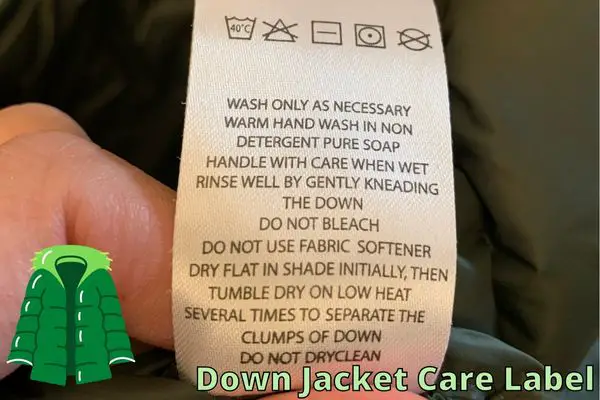
Third, hang dry your down jacket whenever possible; if you must put it in a dryer use low heat settings and remove it promptly once finished. Finally, store your down jacket in a cool place away from direct sunlight and moisture to keep its shape intact for years to come.
Taking care of your down jacket is essential for its longevity and waterproofness. With the right maintenance, you can ensure that your down jacket will keep you warm and dry on any outdoor adventure. Next, let’s look at whether or not down jackets are actually waterproof.
Key Takeaway: Down jackets are an essential part of any outdoor enthusiast’s wardrobe, providing warmth and insulation. To keep them looking and performing their best, here are some tips: – Spot clean or hand wash with cold water and mild detergent – Fluff up feathers after drying – Repel water using waterproof sprays before heading out into wet weather conditions – Store in a breathable garment bag or cotton pillowcase to prevent mold growth due to condensation buildup. By following these steps you can ensure your down jacket remains in top condition for years to come!
Final Conclusion
Puffer jackets are great for outdoor activities, especially during the colder months. With their lightweight insulation, they can keep you warm in snowy or windy conditions and even help to reduce your body’s heat loss.
Whether you choose a down puffer jacket or one with synthetic filling, there is an option for keeping you comfortable no matter what temperature it is outside.
To find out more about which type of puffer jacket would be best suited to your needs and other tips on choosing winter apparel for outdoor activities, see our other blog post for more info on how to choose your outdoor apparel.
References
Super helpful data sheet comparing down puffer jackets from Reddit:

